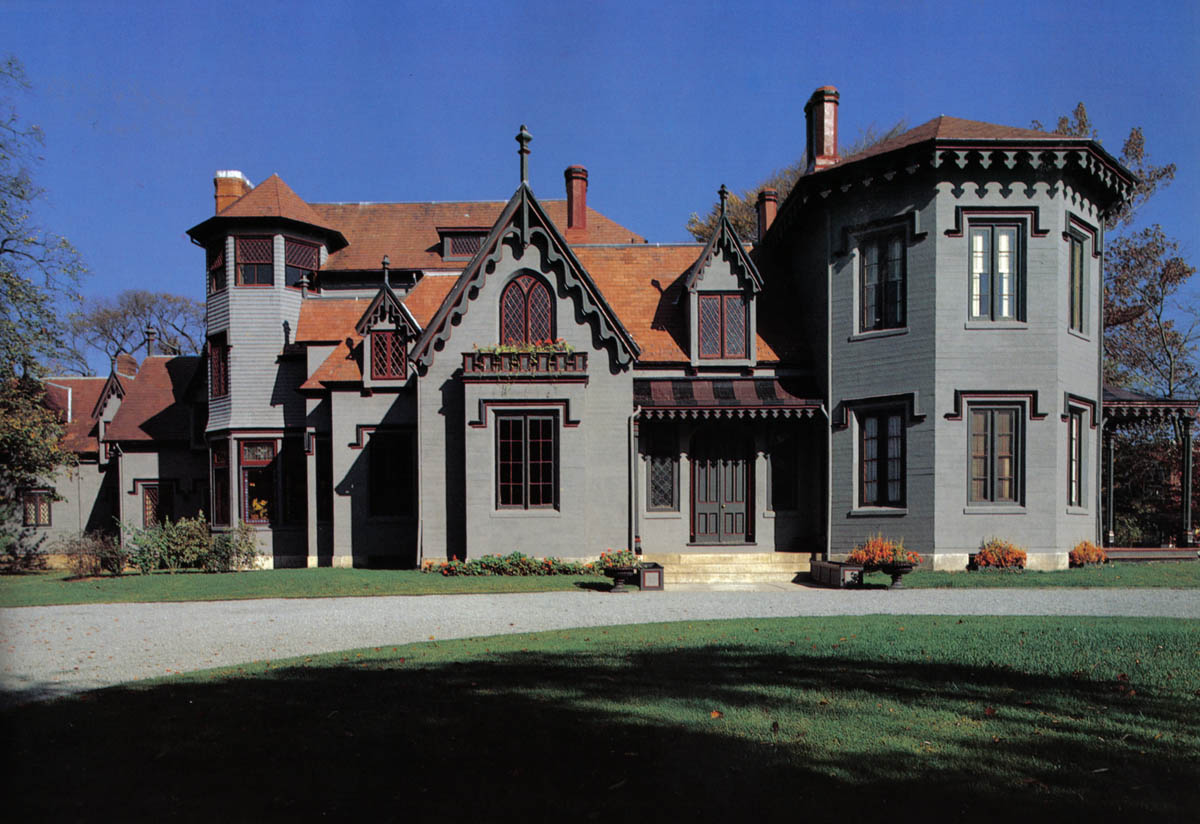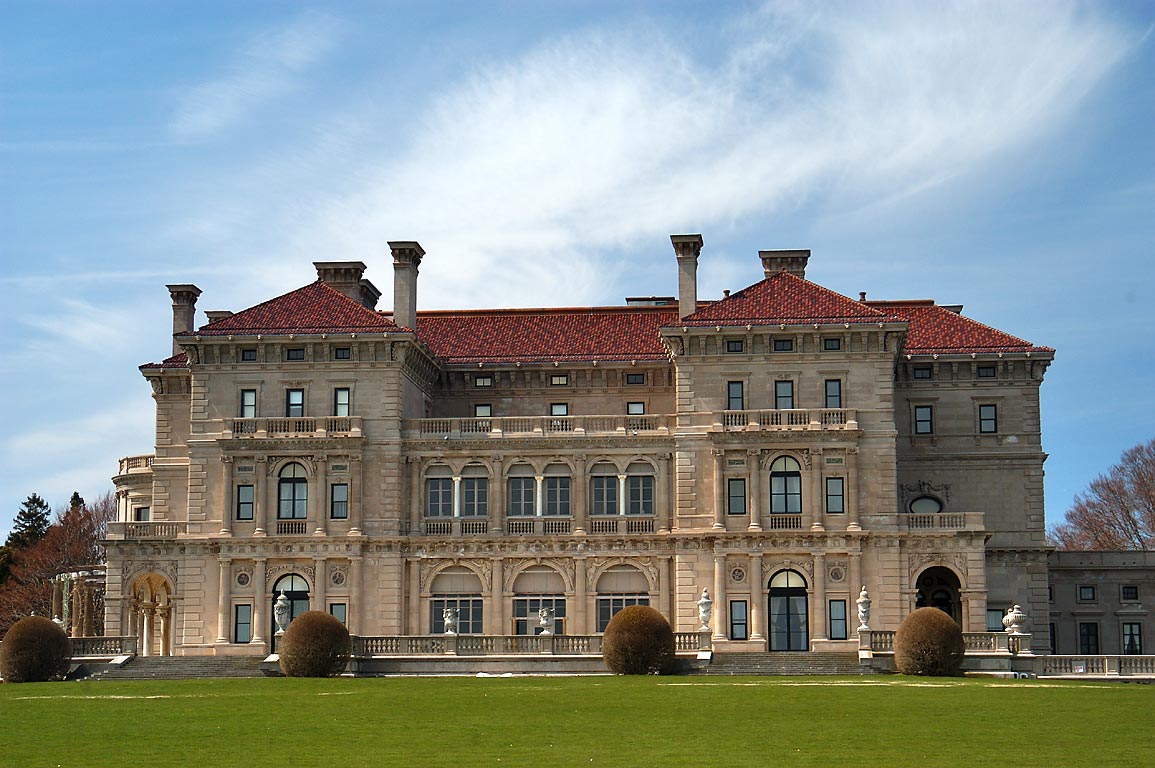Before the founding of the Preservation Society, Newport was both very different than it once was as well as different from what it has now become. In 1945, the glories of the Gilded Age were long past, broken by the 4 sequential catastrophes of World War I, the implementation of the Federal Income Tax, the Great Depression, and then World War II. In the Point neighborhood, many of the Colonial Era houses had been transformed into tenements and boarding houses for people who worked on the Navy Base or the Torpedo Factory on Goat Island. On Bellevue, many of the mansions of the 19th century sat empty and decaying, great “White Elephants” of another era that could no longer be cared for.
Rumor got back to the small cadre of “Old Newporters” that Hunter House on Washington Street, a fine example of mid-Georgian architecture that had been built in 1745 and which had housed Admiral de Ternay during the American Revolution, was going to be demolished. They also heard that the beautiful interior paneling was going to be removed and shipped to the Metropolitan Museum in New York before demolitions and reassembled in the galleries, as an exemplary model of colonial craftsmanship. A few from this group got together and decided that this house should be preserved in its current location and restored. Katherine Warren was one of the city’s leading summer residents at the time and helped lead the effort to acquire the property and fix it. In 1945, knowing that it would be expensive to repair and offer for visitation, she and a few others founded the Preservation Society of Newport County (PSNC) to help take care of the expenses. From their modest efforts to try and save one small house from being destroyed, a mighty preservation movement was born here in Newport that soon spread nationwide. Later, to help pay for the repair and upkeep of Hunter House, Mrs. Warren arranged with her friend Countess Szapary to offer tours of the largely unused Breakers Mansion. While the Breakers, at that time, continued to be owned by the Countess, the PSNC took over the care and maintenance of the structure as part of the agreement to use the building to help generate funds for the organization and the preservation effort began to grow.

Kingscote
Newport was an ideal (and almost unique) place for such a preservation movement to occur. From its very early days, Newport was a wealthy Colonial city – the fifth largest in North America at the date of the Declaration of Independence. As a result, the city had a large number of structures from that era, including some of the earliest structures of their type. These notable buildings include the Quaker Meeting House (1699), the Old Colony House (1739), Trinity Church (1742), the Redwood Library (1747), Touro Synagogue (1758), the Brick Market (1768), and many others. But unlike the other major Colonial cities like New York, Boston, and Philadelphia, after the Revolutionary War, Newport underwent a long decline in population and economic prospects. This had the effect of, somewhat accidentally, preserving many of the colonial structures and instilling a care and thriftiness within the community. For 100 years, buildings were rarely torn down, but more commonly disassembled and moved when they had outlived their purpose at a given particular site. This native bent towards practical architectural preservation is perhaps one of the reasons that Newport and the American architectural preservation movement have become so closely aligned over the proceeding centuries and so Newport had a great stock of architecture of character, quality and value that was waiting patiently to be preserved.

The Breakers Mansion
Beginning with Hunter House but then extending to the Elms, Marble House, Kingscote, the Breakers, Chateau Sur Mer, Rosecliff, Green Animals in Portsmouth, Chepstowe, and then lastly the Isaac Bell House in 1994, the Preservation Society has assembled a collection of world class buildings from different eras that show not only the architectural development of Newport, but also the architectural evolution of America. It was in Newport that some of the finest American architects executed their best work for clients who both wanted to make a grand and bold statement with their buildings and had the budget to make it happen. Nearly all of these structures have now been placed on the Secretary of the Interiors list of National Historic Monuments, which is the highest honor that can be bestowed on an individual building.
Over the years, this small effort that began with the founding of the PSNC has grown into an internationally recognized group that employs more than 400 people, operates 11 properties for visitation, and welcomes more than 1 million paying visitors annually. Katherine Warren’s insight, that the old structures around Newport were not simply outdated structures destined for decay and demolition, but the potential source of tourist visitation, and therefore a potential foundation for economic prosperity, was seismic when viewed in retrospect.
Over the years, the Preservation Society portfolio of properties expanded through the generosity of donors, and in many cases property owners as well, who wanted to see their homes preserved for posterity.
Today, the PSNC is one of the most visited non-profit institutions in New England and a major economic driver for the city of Newport. It is also on par with the National Trust, which was founded in 1949 by Congressional Charter. The organization currently owns and operates 9 properties independently and another 11 in joint stewardship with other non-profit organizations. Its annual visitation at the Breakers is among the highest in the world for any historic house museum, including that of the great, palatial English country homes that are part of the United Kingdom’s National Trust.
In 1945, when the Preservation Society was founded, the organization was on the cutting edge of the American architectural preservation movement. In 2021, 76 years later, it continues to remain so and all Newporters should take pride in and support its future successes.
Looking to design or remodel your home to its fullest potential? Let’s discuss your plans.
Join the Architectural Forum to stay up-to-date with architectural news from Rhode Island and abroad.
Ross Sinclair Cann, AIA, LEED AP, is an historian, educator, author and practicing architect living and working in Newport for A4 Architecture. He is the founding Chairman of the Newport Architectural Forum and holds honors degrees in Architectural History and Design from Yale, Cambridge, and Columbia Universities.
